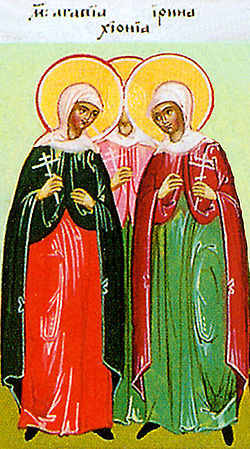Top Qs
Timeline
Chat
Perspective
April 16 (Eastern Orthodox liturgics)
From Wikipedia, the free encyclopedia
Remove ads
April 15 - Eastern Orthodox liturgical calendar - April 17

All fixed commemorations below are observed on April 29 by Eastern Orthodox Churches on the Old Calendar.[note 1]
For April 16th, Orthodox Churches on the Old Calendar commemorate the Saints listed on April 3.
Saints
- Hieromartyrs Felix, Bishop of Spoleto,[note 3] and Januarius, Presbyter, and Martyrs Septeminus and Fortunatus, of Lycaonia (294 or 304)[1][2][7] (see also: August 30)
- Virgin-martyrs Agape, Irene, and Chionia of Aquileia, in Thessaloniki (304)[1][2][8][9] [note 4] (see also: April 3)
- Saints Agatho, Eutychia, Cassia and Phillippa, the Confessors, in Thessaloniki, by imprisonment (304)[10]
Remove ads
Pre-Schism Western saints
- Virgin-martyr Encratia (Encratis, Encratide, Engracia), who suffered terribly for her faith in Saragossa in Spain (c. 304)[1][11][note 5][note 6]
- The Eighteen Martyrs of Saragossa (c. 304):[11][13][note 7] (see also: November 3)
- Optatus, Lupercus, Successus, Martial, Urban, Julia, Quintilian, Publius, Fronto, Felix, Caecilian, Eventius, Primitivus, Apodemius and four named Saturninus.
- Saint Turibius of Astorga, Bishop of Astorga in Spain and a valiant defender of Orthodoxy (c. 460)[11][14]
- Saint Vasius (Vaise, Vaize), a rich citizen of Saintes in France, murdered by his relatives for giving his property to the poor (c. 500)[11][15]
- Saint Turibius of Palencia, founder of the monastery of Liébana in Asturias in Spain (c. 528)[11][note 8]
- Saint Paternus (Pair), Bishop of Avranches (c. 574 or 563)[11][12] (see also: April 15)
- Saint Fructuosus of Braga in Iberia (665)[1][11][12][16][note 9]
- Saint Lambert of Saragossa, a servant who was martyred near Saragossa by his Saracen master (c. 900)[1][11][12]
- Saint Herveus of Tours (Hervé), monk at the monastery of St Martin of Tours, and hermit (1021)[11]
- Saint Elias, Monk and Abbot in Ireland and Germany (1042)[11][note 10]
Remove ads
Post-Schism Orthodox saints
- Saint Theodora-Bassa, princess of Novgorod (1378)[1][17][18][note 11]
- Saint John, Fool-for-Christ, of Verkhoturye (1701)[1][19]
- New Martyr Michael Burliotes of Smyrna, by beheading (1772)[1][2][20][21]
- New Monk-martyr Christopher of Dionysiou, Mt. Athos, at Adrianople (1818)[1][2][22]
- New martyrs Christodoulos and Anastasia, in Achaia (1821)[23]
- Saint Ambrose (Khelaia) the Confessor, Catholicos-Patriarch of All Georgia (1927)[24] (see also: March 16 and March 27)
- Venerable Amphilochios (Makris), Elder, of Patmos (1970)[25][note 12] (see also: April 3 - os)
Other commemorations
Icon gallery
- Virgin-martyrs Agape, Irene, and Chionia.
Notes
- The notation Old Style or (OS) is sometimes used to indicate a date in the Julian Calendar (which is used by churches on the "Old Calendar").
The notation New Style or (NS), indicates a date in the Revised Julian calendar (which is used by churches on the "New Calendar"). - A virgin who suffered terribly for Orthodoxy in Saragossa in Spain, where a church dedicated to her now exists. She was famous for 'her ardour in suffering for Christ'. Though counted a martyr, she outlived her torments.
- "At Saragossa, in Spain, the birth day of eighteen holy martyrs, Optatus, Lupercus, Successus, Martial, Urbanus, Julia, Quinctilian, Pubilus, Fronto, Felix, Caecilian, Eventius, Primitivus, Apodemius, and four others, who, it is said, bore the name of Saturninus. Under Dacian, governor of Spain, they were all together subjected to torments and slain. The glory of their martyrdom has been celebrated in verse by Prudentius."[12]
- Born in Spain, he became a monk and then a hermit in the Vierzo Mountains, where disciples gathered around him. Fructuosus was eventually forced to become Bishop of Dumium and later Archbishop of Braga.
- Born in Ireland, he became monk and abbot in 1020 of the Irish monasteries of St Martin the Great and St Pantaleon in Cologne in Germany.
- The Synaxaristes list her death date as 1347.
- He was glorified by the Holy Synod of the Ecumenical Patriarchate of Constantinople on August 29, 2018:[26]
- (in Greek) α) Εἰσηγήσει τῆς Κανονικῆς Ἐπιτροπῆς συμπεριελήφθη εἰς τό Ἁγιολόγιον τῆς Ὀρθοδόξου Ἐκκλησίας ὁ ἐν Πάτμῳ ἀσκήσας καί ἀναπτύξας μέγα πνευματικόν καί κοινωφελές ἔργον ἐν Δωδεκανήσῳ, Κρήτῃ καί ἀλλαχοῦ Ἀρχιμανδρίτης Ἀμφιλόχιος Μακρῆς, διατελέσας Ἡγούμενος τῆς ἱστορικῆς Ἱερᾶς Μονῆς Ἁγίου Ἰωάννου τοῦ Θεολόγου καί Πατριαρχικός Ἔξαρχος Πάτμου, ὅστις καί ἵδρυσε τήν ἐν τῇ Νήσῳ γυναικείαν Ἱεράν Μονήν Εὐαγγελισμοῦ Μητρός Ἠγαπημένου.[27]
Remove ads
References
Sources
Wikiwand - on
Seamless Wikipedia browsing. On steroids.
Remove ads

